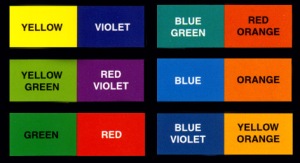Colour
All colors are the friends of their neighbours and the lovers of their opposites.
(Marc Chagall)
The Basics of Colour Theory and Paint.
The Basics of Colour
How we see colour is determined by light, human perception and the chemistry of paint. There are many theories of colour, all are constructs to understand or to create a system to identify colours. Black and white are not considered to be colours at all but rather the absence or combination of colours – black being a combination of all colours and white the absence of any colour. Below are some definitions and categories of colour that may be useful. At the end is a list of recommended paint colours for a beginning paint set.
PRIMARY COLOURS: The primary colours are red, yellow and blue.
![]()
SECONDARY COLOURS: The secondary colours are the three primary colours mixed with each other to create orange, green and purple.
red + yellow = orange
yellow + blue = green
blue + red = purple

It is not possible to mix every colour using the three primary colours and black and white, despite it being a commonly held belief. There are many new vibrant paint colours available now such as quincridone magenta or some turquoise colours which are not possible to be made by mixing red, yellow and blue.
By mixing all three primary colours together you will end up with a dark grey/black.
The colours you will be able to mix will vary greatly depending on which yellow, blue and red you use. For example to make beautiful grassy and limey greens mix cerulean blue and lemon yellow, for olive greens use cobalt blue and cadmium yellow.
HUE: A hue is the colour family eg. red, green or blue
SHADE: A Shade is any colour mixed with black

TINT: A tint is any colour mixed with white

TONE: A tone is any colour mixed with grey

VALUE: A colour’s value is the relative lightness or darkness of a colour
INTENSITY, SATURATION OR CHROMA: Intensity, saturation or chroma refer to the relative brightness or dullness of a colour
WARM AND COOL COLOURS
On this topic there is some confusion and differing views on categorising colours. In one version the warm colours are yellow, orange and red through to purple and the cool colours are yellow/green and blue through to violet as illustrated below.

The other version of warm and cool colours is that any hue (red,yellow, blue etc) can be cool or warm. A warm colour has a yellow base and would include colours such as vermillion red, cerulean blue and cadmium yellow. The cool colours have a blue base such as cobalt blue, lemon yellow and crimson red.
MONOCHROMATIC: A monochromatic painting would be based around one colour, for example blue and then adding black and white to that blue to create different shades, tones and tints. Monochromatic means using one colour in different values.
COMPLIMENTARY COLOURS: Using colours directly opposite on the colour wheel e.g. orange and blue. The use of complimentary colours can be very effective in creating vibrancy and contrast in a painting. Look at the colour wheel below to see the opposites on each side.

The Colour Wheel
A colour wheel helps determine the results of colour mixing and can be useful for beginners. Many versions are available commercially. A colour wheel consists of two layers of circular card with printed colours on them. The top layer can be turned leaving windows which will show you the results of mixing two colours together.
This colour wheel illustrated is produced by The Colour Wheel Company.
For more information on colour I would recommend purchasing a pocket guide to mixing colour or a colour wheel. These would be available from your local art supplies shop.
Basic Palette of Colours
This is a list of common paint colours that you can use to mix most other colours from and what I would recommend as a starting set to purchase.
white (most used, buy a tub rather than a tube)
yellow ochre
lemon yellow
cadmium yellow
crimson red
napthol red
cerulean blue
ultramarine blue
cobalt blue
paynes grey
brown/black
The Cultural Influences of Colour
Black can represent: death, the devil, depression, villainy, darkness, disaster and mourning
White can represent: purity, light, death, corruption, truth, innocence, the sacred, fear, cowardice and coldness
Blue can represent: sadness, isolation, serenity, harmony, depression, cool, cold, life, masculine, feminine, eternity, faith, wisdom, mercy and fidelity
Pink can represent: feminine, pretty, calming and youth
Violet can represent: enlightenment, penitence, royalty, moderation, transition and wealth
Green can represent: nausea, sickness, spring, life, freshness, vitality, ecology, jade – longevity, strength, fertility, immaturity and envy
Yellow/gold can represent: divinity, glory, royalty, truth, happiness, cowardice, treachery, disloyalty, sickness
Red can represent: anger, vibrancy, blood, life, energy, good luck, celebration, virtue, fire, aggression, festivity, love, passion, strength, youth, war and good luck
To learn more about symbols, colours and their meanings there are books available that may be of interest, look for a dictionary of symbols.
FOR FURTHER INVESTIGATION
Look at painters interested in colour theory such as colour field painters. These included Mark Rothko, Barnett Newman, Clyfford Still and Helen Frankenthaler.
Research colour theory more by looking at Johannes Itten’s books on the subject.

You post great articles Just bookmarked !!!
April 10, 2011 at 11:54 am
Pingback: Colors | An Exploration Of Art and Writing Comparatively